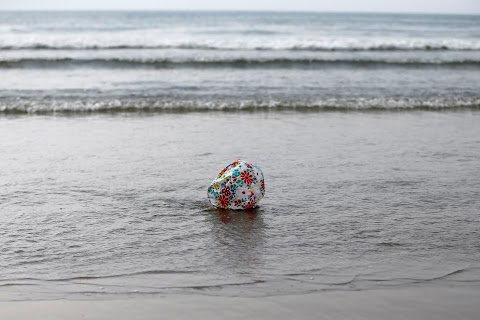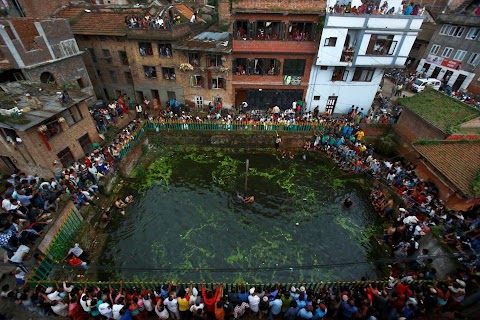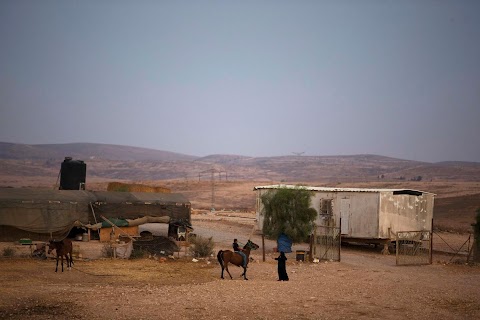
Another world
 Jorge Silva
Jorge Silva
A fish swims past a scuba diver navigating through the teeming waters of the Galapagos Marine Reserve, host to a huge array of wildlife, from hawksbill turtles to hammerhead sharks.
Straddling the equator around 1,000 km (621 miles) off the coast of Ecuador, the Galapagos Islands lie amid a complex system of ocean currents, which help sustain the rich biodiversity of their waters.

The skeleton of an iguana lies on Isabela Island, at Galapagos National Park. The reptiles are part of the Galapagos' unique fauna, famous not only for its diversity, but also for having been studied by Charles Darwin when he visited the islands in 1835, on a voyage that helped inspire his theory of evolution.
Slideshow

A Zayapa red crab perches on a rock at Punta Albemarle in Isabela Island, the largest landmass in the Galapagos archipelago.

A tuna swims among a school of fish as a scuba diver looks on at Galapagos Marine Reserve.

A hammerhead shark swims in waters close to Wolf Island, one of the most remote areas of the Galapagos, and home to particularly rich underwater wildlife.

A scuba diver watches a shark close to Darwin Island.

Sea lions swim near San Cristobal, which lies at the eastern end of the archipelago and is the first of the islands that Darwin visited.

A scuba diver takes pictures of a turtle close to Wolf Island.

A giant tortoise lumbers down a road at Santa Cruz island at Galapagos National Park.

Iguanas unique to the Galapagos sit on a rock at Isabela Island.

An iguana sits in bright light.

Tourists ride a boat as they look at the pinnacle rock at Bartolome Island.

A photo from the top of Bartolome shows a wide vista of the Galapagos.
"The Galapagos Islands are a dream come true for both divers and photographers, even more so when the two professions are combined into one."
Once your eyes go below the ocean waterline, you know that you are about to encounter an immense parallel universe, brimming with images.
Ever since I began taking pictures I haven’t discovered anything that grabs me like diving does. Luckily, I don’t have to neglect photography while exploring the depths; the two activities are perfectly complementary.
But photographing underwater is a challenge due to the inherent demands of diving, and the technical difficulties that underwater photography presents.
Diving requires calm and concentration, with control over every variable – floatability, depth, air, and time – while shooting underwater can break that coolness. Going after an image can require me to swim a little more than expected, and consume more air than calculated. The human body requires more oxygen to move more muscles.
The Galapagos Islands are a dream come true for both divers and photographers, even more so when the two professions are combined into one. Located on the geographical equator in the Pacific Ocean, this volcanic deep-sea archipelago consists of 15 major islands and 107 islets, is home to two UNESCO World Heritage sites, the Galapagos National Park and the Galapagos Marine Reserve. The latter is the second largest marine reserve in the world, after the Great Barrier Reef in Australia.
Thanks to a complex system of ocean currents, which bring nutrients that help sustain marine life, more than 2,900 marine species have been reported here. Of those, more than 18 percent are endemic. It is one of the richest and most complex ecosystems on Earth.
Scientists, naturalists and tourists have visited the islands for decades now, but only over the past 20 years have they become a diving destination.
For me, it was like travelling to another planet. We embarked on a seven-day journey (with a dose of seasick pills every eight hours) by boat along the north side of the archipelago, with the goal of diving in the two northernmost islands, Darwin and Wolf. Their waters hold the largest quantity of marine fauna.
After the second night of sailing we woke up next to a breathtaking cliff, about 100m high. We had reached Wolf. At 6:30 a.m., just like every morning, we began our series of dives (up to four a day).
Down under, with strong currents and cold water as low as 14 degrees Celsius (57 degrees Fahrenheit), there were dozens of hammerhead sharks, Galapagos sharks and the occasional whale shark. We swam through huge fish banks, which sometimes were so dense that they almost blocked the sun.
It was a breathtaking display of the perfect choreography of underwater species.
Formerly a pirate haven, then a scientific paradise, and now a phenomenal source of tourism revenue, the islands face a future riddled with challenges. They must preserve a good balance between conservation of their spaces and species, and economic development. Their efforts are concentrated in the promotion of sustainable tourism, stopping the migration of invading species and new settlers, and maintaining restrictions against industrial fishing.
All this, in addition to their significant vulnerability to global warming, threatens the Galapagos endemic species. Is paradise at risk?














